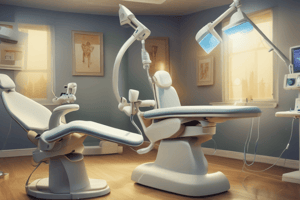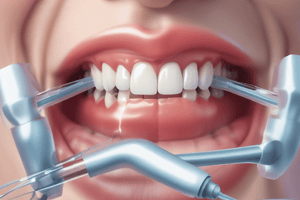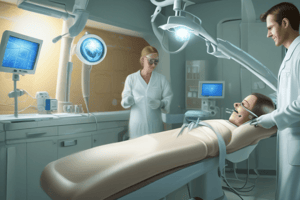Podcast
Questions and Answers
What is necessary for achieving population inversion in a laser system?
What is necessary for achieving population inversion in a laser system?
- Random distribution of atoms in energy levels
- Direct excitation of atoms
- Use of a suitable energy source (correct)
- Activation of all atoms simultaneously
Which characteristic does NOT describe laser radiation?
Which characteristic does NOT describe laser radiation?
- Coherence
- Monochromaticity
- Divergence (correct)
- Directionality
In the ruby laser system, what role does the flashtube play?
In the ruby laser system, what role does the flashtube play?
- It serves as the laser medium
- It acts as a cooling system
- It supplies energy to the laser medium (correct)
- It generates laser radiation directly
What energy level is known as the metastable state in the ruby laser?
What energy level is known as the metastable state in the ruby laser?
What is the wavelength of the light emitted by a ruby laser?
What is the wavelength of the light emitted by a ruby laser?
What is the primary mechanism by which population inversion is achieved in the metastable state E2?
What is the primary mechanism by which population inversion is achieved in the metastable state E2?
What occurs during the stimulated emission of radiation?
What occurs during the stimulated emission of radiation?
Which characteristic is true regarding the Er:YAG laser?
Which characteristic is true regarding the Er:YAG laser?
What is the effect of the photon interactions in the active medium of a laser?
What is the effect of the photon interactions in the active medium of a laser?
Which of the following statements best describes lanthanide lasers?
Which of the following statements best describes lanthanide lasers?
Flashcards
Laser
Laser
Light Amplification by Stimulated Emission of Radiation (LASER).
Population Inversion
Population Inversion
More atoms/molecules in a higher energy state than a lower one.
Ruby Laser Components
Ruby Laser Components
Uses a ruby crystal (aluminum oxide doped with chromium ions) as the lasing medium and a flashtube as an energy source.
Laser Requirements
Laser Requirements
Signup and view all the flashcards
Ruby Laser Properties
Ruby Laser Properties
Signup and view all the flashcards
Metastable State in Lasers
Metastable State in Lasers
Signup and view all the flashcards
Population Inversion in Lasers
Population Inversion in Lasers
Signup and view all the flashcards
Spontaneous Emission in Lasers
Spontaneous Emission in Lasers
Signup and view all the flashcards
Stimulated Emission in Lasers
Stimulated Emission in Lasers
Signup and view all the flashcards
Laser Light Amplification
Laser Light Amplification
Signup and view all the flashcards
Study Notes
Lasers in Dentistry
- Lasers are light amplification by stimulated emission of radiation
- Population inversion is required for laser generation. This means a higher number of atoms/molecules need to be in higher energy levels than lower energy levels. Direct excitation doesn't achieve this, giving only ~50% excited atoms.
- Laser operation requires stimulated emission, and population inversion.
Laser Requirements
- Stimulated emission: A photon interacts with an excited atom, causing it to drop to a lower energy level and emit a new, identical photon (same wavelength)
- Population inversion: More atoms need to be in a higher energy level than a lower energy level. This is achieved in specific ways, as shown in the different types of lasers highlighted in the text.
Ruby Laser
- A three-energy-level solid-state laser, using synthetic ruby crystals
- Developed by Maiman in 1960
- Emits deep red light (694.3 nm)
- Uses a ruby crystal (Al2O3: Cr3+) as a laser medium
- Doped with chromium (Cr3+) ions in sapphire (Al2O3)
- Uses a flashtube as an energy source/pump to excite chromium ions
- High thermal properties of ruby
Laser Properties
- Monochromaticity: Photons have the same wavelength
- Directionality: Beam is parallel and not divergent
- Coherence: Photons propagate in phase
- Brightness: High intensity, compared to ordinary light sources
Other Solid-State Lasers
- Er:YAG lasers: Emit infrared light (2.940 µm), used in dentistry
- Erbium belongs to the rare-earth metal family
- Lasers based on rare-earth doped gain media are sometimes called lanthanide lasers
- Other solid-state lasers like Nd:YAG, Nd:YAG doubled, Argon ion, CO2, and Dye lasers; wavelength, and mode information given in Table in page 18.
- GaAlAs lasers emit mainly near-infrared photons at 980 nm.
- KTP lasers emit visible light at ~532nm
Gas Lasers
- Helium-Neon (He-Ne) lasers: Four-energy-level laser, with population inversion of Ne. Uses energy transfer from electrically excited He atoms. He:Ne ratio is typically 10:1. Emits a wavelength of 632.8 nm.
- Carbon Dioxide (CO2) lasers: Vibrational transitions in CO2 molecules produce laser emission (10.6 and 9.4 µm). Uses vibrational energy levels of CO2. He gas helps with pumping by efficient production of the first vibrational state of N2.
Human Teeth and their Chemical Composition
- Water absorbs in the ultraviolet (UV) and infrared (IR regions)
- Hydroxyapatite (a main component of dental tissues) absorbs strongly at ~10 µm in the IR region
Laser Applications
- Laser welding of detached eye retina
- Laser lithotripsy of calculi
- Selective bond breaking using lasers
- Laser capture microdissection (LCM)
Additional Information
- Wavelengths listed for various laser types
- Specific materials like hydroxyapatite & titanium
- Energy transfer processes for lasing
- Diagnostic techniques & safety considerations (e.g. MRI compared to CT
- Specific reaction types for certain applications (e.g., bond breaking)
Studying That Suits You
Use AI to generate personalized quizzes and flashcards to suit your learning preferences.




